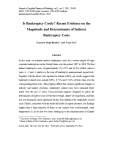
Large corporate bankruptcies
-
Is bankruptcy costly? Recent evidence on the magnitude and determinants of indirect bankruptcy costs
In this study we estimate indirect bankruptcy costs for a recent sample of large corporate bankruptcies in the United States over the period, 1997 to 2004. We find indirect bankruptcy costs of approximately 2%, 6.2% and 14.9% of firm value in years -3, -2 and -1 relative to the year of bankruptcy announcement respectively. Together with the direct costs reported in Altman (1984), our results suggest total bankruptcy related costs around 6.09%, 9.71% and 17.43% of firm value over the corresponding three years.
 30p
30p  nguyenminhlong19
nguyenminhlong19
 21-04-2020
21-04-2020
 8
8
 1
1
 Download
Download
-
Improvement of life insurance policyholders’ protection corporation with emphasis on consistency with the Vietnamese market. What is needed for the Life Insurance Policyholders’ Protection Fund in Vietnam is to review and improve its system so that it is consistent with any anticipated changes of the insurance market in Vietnam, by taking advantage of the experience of the Life Insurance Policyholders’ Protection Corporation in Japan where large scale bankruptcies have occurred in series.
 23p
23p  tranminhluanluan
tranminhluanluan
 28-05-2018
28-05-2018
 19
19
 3
3
 Download
Download
-
The special handling of troubled assets is not uncommon in the day-to-day activities of the banking world. For example, non-performing corporate loans are typically transferred to a work-out department. 8 In the case of large loan amounts, the individual lenders form creditor pools in order to prevent coordination failures and a sudden withdrawal of lenders that can force a financially distressed firm into bankruptcy. 9 In the past, work-outs have often resulted in loans being converted into share capital.
 193p
193p  enterroi
enterroi
 02-02-2013
02-02-2013
 45
45
 7
7
 Download
Download
-
However, there is no study to date that examines the informational efficiency of the secondary market for loans relative to the market for bonds of the same corporation, largely due to the unavailability (at least until now) of secondary market prices of loans. Our study fills this gap in the literature. Specifically, we examine, using a unique dataset of secondary market daily prices of loans from November 1, 1999 through July 31, 2002, whether the loan market is informationally more efficient than the bond market. Given the nature of our sample period (i.e.
 42p
42p  enter1cai
enter1cai
 16-01-2013
16-01-2013
 73
73
 9
9
 Download
Download
CHỦ ĐỀ BẠN MUỐN TÌM
















